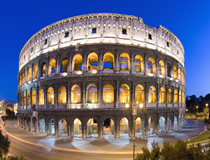ROMAN COLOSSEUM

The Roman Colosseum, also known as the Flavian Amphitheatres or the Coliseum, is one of the most glorious pieces of Roman architecture and one of the best tourism destinations in Rome nowadays. Located a little to the east of the Roman Forum, the enormous structure was constructed between 70 AD and 86 AD, and it has survived for nearly two millennia since, though it's currently partially ruined. Once capable of accommodating up to 50,000 people, during the height of Roman Empire, it was the best location to see many public attractions, including theater, animal hunts, battle reenactments, mock sea battles, public executions and of course, gladiatorial competitions. As many as a 500,000 people and twice as many animals are believed to have killed when it was open, with over 9,000 wild animals butchered just for its inauguration
MAIN FEATURES :
The Colosseum was shut down as an entertainment attraction in the beginning of medieval period after a petition by the growing Christian population and was later used for many things from a shrine to a quarry to a fortress. The Colosseum was declared a sacred area in the mid-18th century by Pope Benedict XIV, although there were no strong evidences that Christians were once martyred there, and later Popes repaired and restored it somewhat, reinforcing the entire structure with brick wedges and removing wild vegetation.
Originally, the amphitheatre had upper levels made from wood, which have disappeared now, and the Colosseum has also been heavily damaged by earthquake and fire. Until the building was declared a shrine, locals removed stone and woods from it for constructing other buildings, as well. The badly damaged building now stands as a permanent symbol of Rome's grandness, and is visited by many tourists every day.
Excavations of the structure began in the 19th century until the 1930s. More recently, a renovation project between 1993 and 2000 improved parts of the outer wall. The Colosseum has also become a large symbol for capital punishment activists, and is illuminated in gold whenever a death penalty is commuted or when a country abolishes the capital punishment.
Some vital information for visitors::
Since the interior remains ruined, it is no longer possible to host big events. However, 200-300 people can be seated inside, while more can be seated outside the building, using the famous landmark as a concert backdrop. The Colosseum is often visited by photo taking crowds on average days, and is best photographed in the morning, when it is less crowded.
